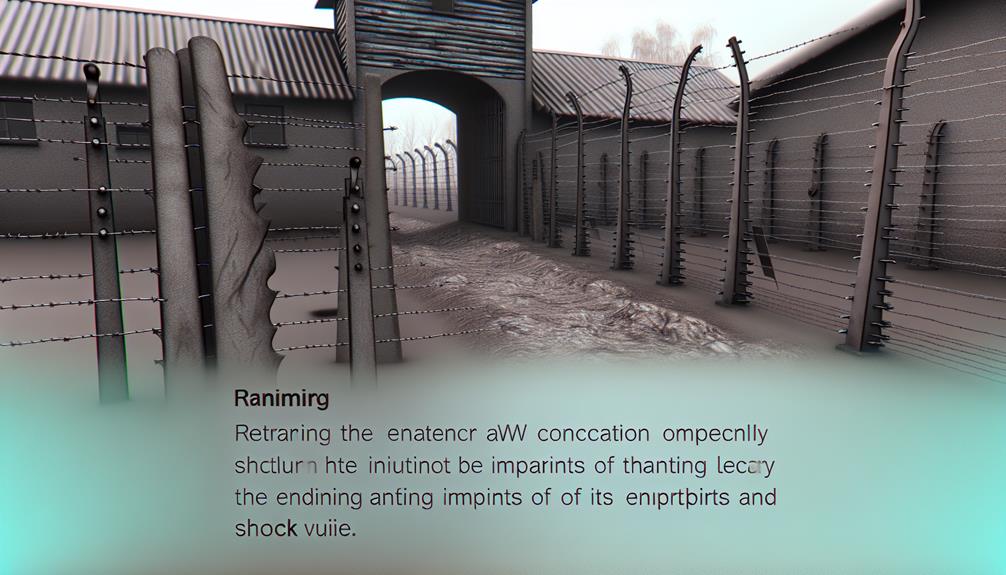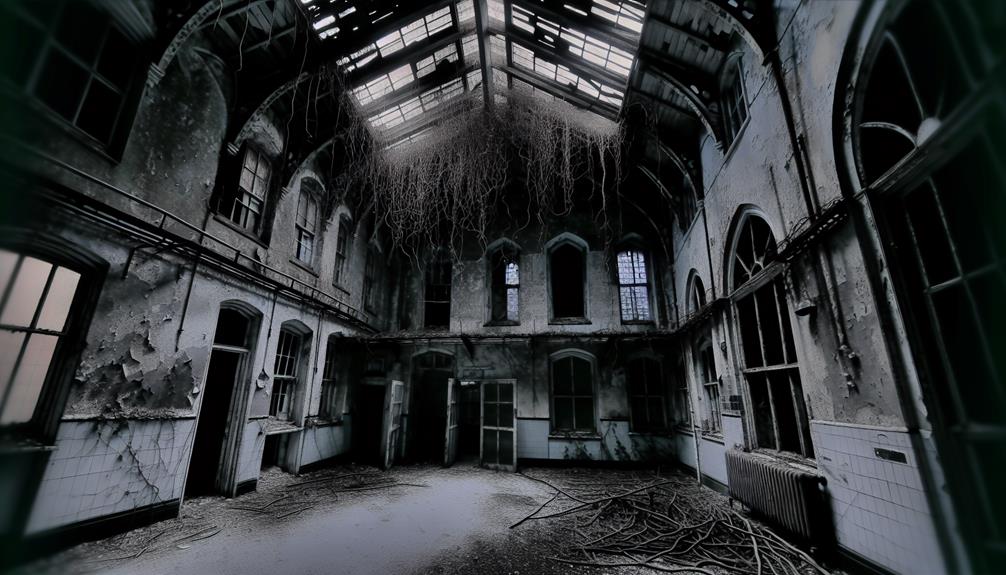Dachau, Germany's inaugural concentration camp, harbors a narrative that transcends mere historical documentation; it serves as a somber proof to the darkest chapters of human history. The haunting echoes of its past reverberate through its grounds, offering a glimpse into the unspeakable horrors that unfolded within its confines. The exploration of Dachau's legacy reveals profound insights into the complexities of power, the resilience of the human spirit, and the enduring quest for justice and remembrance. As we begin to unravel the intricate layers of Dachau's story, a poignant journey awaits, inviting contemplation and introspection into the depths of our shared humanity.
Key Takeaways
- Dachau was Germany's first concentration camp, established in 1933.
- The camp embodied fear, dehumanization, and control through harsh treatment.
- Liberation uncovered survivors' physical and psychological scars.
- Dachau's legacy serves as a poignant reminder of the Holocaust.
- Architectural design aimed at maximizing control and degradation of prisoners.
Establishment of Dachau Camp
In 1933, the Dachau concentration camp was established by the Nazi regime in Germany as the first of its kind. The camp conditions at Dachau were designed to instill fear, dehumanize prisoners, and facilitate control through harsh treatment and systematic oppression. Prisoner experiences at Dachau were marked by extreme overcrowding, inadequate sanitation, and grueling labor under the constant threat of violence and death.
Upon its establishment, Dachau served as a model for future concentration camps, setting a precedent for the deplorable conditions and inhumane treatment that would become synonymous with the Holocaust. The camp was originally intended for political prisoners, primarily targeting individuals considered enemies of the Nazi regime, such as communists, socialists, and intellectuals. However, as the camp evolved, it began to incarcerate individuals based on race, religion, and other arbitrary criteria.
Prisoners at Dachau endured unimaginable hardships, including malnutrition, disease, and brutal punishments meted out by the SS guards. Many prisoners were subjected to medical experiments, forced labor, and psychological torture, further exacerbating their suffering. The psychological impact of living in constant fear, uncertainty, and deprivation left lasting scars on those who survived the horrors of Dachau.
The establishment of Dachau marked the beginning of a dark chapter in history, highlighting the depths of human cruelty and the resilience of the human spirit in the face of unimaginable adversity.
Life Inside the Camp
Following the establishment of Dachau as the first concentration camp in Germany, a stark and harrowing reality awaited those who were confined within its walls, as they grappled with the brutalities and dehumanizing conditions of life inside the camp. Daily routines in Dachau were marked by extreme hardship and suffering. Prisoners were subjected to long hours of forced labor, often under inhumane conditions, leading to exhaustion and malnourishment. The monotony of their routines was only broken by moments of intense fear and violence at the hands of the SS guards.
Social dynamics within the camp were shaped by fear and survival instincts. The hierarchical structure imposed by the guards pitted prisoners against each other, fostering a climate of mistrust and betrayal. Solidarity among inmates was rare, as self-preservation became the primary focus for many. The constant threat of punishment or death hung over the prisoners, creating a pervasive atmosphere of terror and despair.
Despite these harsh circumstances, acts of kindness and solidarity did occasionally emerge among the inmates, providing glimmers of humanity in an otherwise dehumanizing environment. These small gestures of compassion served as a reminder of the resilience of the human spirit, even in the face of unimaginable cruelty. The daily struggle for survival in Dachau left an indelible mark on those who lived through it, shaping their lives long after they were liberated.
Liberation and Aftermath
The aftermath of the liberation of Dachau concentration camp brought to light the profound physical and psychological scars endured by the survivors, as they grappled with the challenging task of rebuilding their shattered lives. The liberation marked the beginning of a long and arduous journey towards post-war healing for those who had suffered unimaginable atrocities within the camp's walls. Many survivors faced immense challenges in coming to terms with their traumatic experiences and adjusting to a world forever changed by the horrors of the Holocaust.
In the wake of liberation, the issue of historical responsibility loomed large. The world was confronted with the stark reality of the atrocities committed at Dachau and other concentration camps, prompting a collective reckoning with the depths of human depravity. Efforts to document the survivors' testimonies and preserve the memory of the camp became essential in ensuring that future generations would never forget the lessons of the past.
As survivors started on the difficult path to recovery, support networks and organizations were established to assist them in maneuvering the complex process of rebuilding their lives. The legacy of Dachau serves as a poignant reminder of the enduring impact of the Holocaust and the ongoing need to confront the atrocities of the past with a sense of historical responsibility.
Role in the Holocaust
Dachau concentration camp played a pivotal role in the systematic persecution and extermination of millions of individuals during the Holocaust, serving as a harrowing symbol of Nazi brutality and inhumanity. The camp, established in 1933 near Munich, Germany, was not only one of the first concentration camps but also served as a model for many that followed. Nazi propaganda, with its dehumanizing rhetoric and scapegoating of marginalized groups, played a significant role in shaping public opinion and laying the groundwork for the atrocities committed at Dachau and other camps.
Understanding the perpetrator psychology behind Dachau reveals a chilling aspect of the Holocaust. The guards and officials at the camp were not inherently evil; rather, they were ordinary individuals who became perpetrators of heinous crimes. Through a process of indoctrination and desensitization, coupled with a culture of obedience and fear, these individuals were transformed into instruments of terror. The dehumanization of prisoners, fueled by Nazi ideology and propaganda, further facilitated the psychological distance needed to carry out acts of extreme violence and cruelty.
Dachau's contribution to the Holocaust cannot be understated. It exemplifies the intersection of ideology, propaganda, and human psychology in enabling mass atrocities. By examining Dachau's role in the Holocaust, we gain insight into the mechanisms that allowed such horrors to unfold and the importance of vigilance against hate and dehumanization in society.
Architectural Layout and Purpose
The design and layout of the concentration camp at Dachau were meticulously planned to serve the purpose of systematic control, surveillance, and degradation of prisoners within its confines. The architectural design of Dachau played a pivotal role in enforcing the dehumanization and subjugation of inmates. The camp was designed to instill fear, break the spirit of the prisoners, and facilitate the efficient execution of the Nazi regime's atrocities.
| Aspect | Description | Historical Significance |
|---|---|---|
| Central Tower | Oversaw the entire camp, symbolizing control | Emblematic of the camp's strict hierarchical structure |
| Living Quarters | Cramped, unsanitary barracks for prisoners | Reflective of the inhumane living conditions endured |
| Appellplatz | Roll-call area for prisoners twice a day | Used for prisoner counts and intimidation tactics |
The architectural layout of Dachau was a manifestation of the Nazi ideology of domination and oppression. The camp's structures were strategically positioned to maximize surveillance and reinforce the power dynamics between the guards and the prisoners. The layout also facilitated the implementation of systematic abuse and torture, highlighting the depths of human cruelty that transpired within its walls. Understanding the architectural design of Dachau provides valuable insights into the historical significance of the camp and serves as a stark reminder of the atrocities committed during the Holocaust.
Notable Prisoners and Survival Stories
Among the notable individuals who were imprisoned at Germany's first concentration camp, Dachau, are individuals whose survival stories provide essential insight into the endurance and resilience amid extreme adversity. These stories highlight the strength of the human spirit in the face of unimaginable horrors.
One such individual is Horst Fischer, a member of the German resistance movements who was arrested and imprisoned in Dachau for his anti-Nazi activities. Despite enduring brutal treatment and witnessing the atrocities committed within the camp, Fischer never wavered in his commitment to fighting against the oppressive regime. His resilience and hope for a better future inspired many fellow prisoners to hold onto their humanity in the darkest of times.
Another remarkable survival story is that of Margot Hirsch, a Jewish woman who defied the odds by staying hidden within the camp for months before managing to escape. Through sheer determination and quick thinking, she evaded detection and survived the horrors of Dachau. Hirsch's story serves as a proof of the power of hope and the will to live, even in the most dire circumstances.
These individuals, along with many others who faced unimaginable suffering in Dachau, exemplify the extraordinary resilience and courage that emerged in the face of adversity. Their stories remind us of the importance of resistance movements and the enduring strength of the human spirit in the darkest of times.
Medical Experiments and Atrocities
The medical experiments conducted at Germany's first concentration camp revealed the depths of human cruelty and disregard for ethical standards during the wartime atrocities. These experiments, carried out on prisoners at Dachau, included testing the limits of the human body through exposure to extreme temperatures, infectious diseases, and chemical agents. The ethical implications of these experiments are profound, showcasing a complete disregard for the sanctity of human life and the basic principles of medical ethics.
The medical atrocities committed at Dachau hold significant historical importance as they exemplify the extreme measures taken by the Nazi regime in the name of scientific advancement and ideological purity. The experiments conducted in the camp were not only inhumane but also failed to yield any meaningful scientific results, calling into question the motivations behind such heinous acts.
The legacy of the medical experiments at Dachau serves as a stark reminder of the atrocities committed during the Holocaust and the need to uphold ethical standards in scientific research. The stories of those who suffered through these experiments stand as a proof to the resilience of the human spirit in the face of unimaginable cruelty. Remembering and reflecting on these events is vital to ensuring that such atrocities are never repeated in the future.
Memorialization Efforts and Commemoration
Exploring the ways in which Dachau's history is being memorialized and commemorated sheds light on the ongoing efforts to preserve the memory of those who suffered within its confines. The following initiatives contribute to honoring the victims and educating visitors about the atrocities that occurred at Dachau:
- Public art: Various forms of public art have been incorporated into the memorialization efforts at Dachau. Sculptures, installations, and murals serve as poignant reminders of the camp's history and the suffering endured by its prisoners. These artistic expressions provide a visceral and emotional connection to the past, ensuring that the memory of the victims remains vivid and impactful.
- Educational programs: Educational programs play an essential role in ensuring that the history of Dachau is not forgotten. Guided tours, lectures, and workshops offer visitors the opportunity to deepen their understanding of the camp's significance and the broader context of the Holocaust. By engaging with historical experts and firsthand accounts, participants in these programs gain valuable insights into the human experiences that unfolded at Dachau.
These efforts collectively contribute to the preservation of Dachau's history and the commemoration of those who suffered within its walls. By integrating public art and educational programs into the memorialization process, the memory of the victims is honored, and future generations are encouraged to reflect on the lessons of the past.
Impact on Collective Memory
How does the enduring legacy of Dachau as Germany's first concentration camp impact collective memory? The memory preservation efforts and educational programs surrounding Dachau play an essential role in shaping collective memory. Through various initiatives, the historical significance of Dachau is kept alive in the minds of people, ensuring that the atrocities committed there are never forgotten.
| Memory Preservation Efforts | Educational Programs |
|---|---|
| – Maintenance of memorial sites | – School visits to Dachau |
| – Archival documentation | – Lectures and seminars |
| – Survivor testimonies | – Educational workshops |
Memory preservation efforts encompass activities like maintaining the physical sites, archiving historical documents, and collecting survivor testimonies. These initiatives ensure that the memory of Dachau remains vivid and accessible to future generations. On the other hand, educational programs play a significant role in transmitting this memory to a broader audience. School visits to Dachau, lectures, seminars, and workshops provide opportunities for individuals to learn about the camp's history, fostering a deeper understanding of the events that transpired there.
Lessons for Future Generations
In considering the enduring legacy of Dachau, it becomes essential to extract pertinent lessons for future generations. Reflecting on the lessons learned from the history of Germany's first concentration camp can guide us in shaping a more compassionate and just world. Through legacy reflection and educational programs, we can guarantee that the horrors of the past are never repeated and that the memory of those who suffered remains alive.
Here are four key lessons for future generations:
- Importance of Remembrance: Keeping the memory of Dachau alive through memorials, museums, and educational initiatives ensures that the stories of the victims are never forgotten, honoring their legacy and serving as a stark reminder of the consequences of intolerance and hatred.
- Promotion of Human Rights: Emphasizing the importance of upholding human rights for all individuals, regardless of race, religion, or background, is essential in preventing atrocities like those that occurred at Dachau from happening again.
- Vigilance Against Extremism: Remaining vigilant against extremist ideologies and taking a stand against discrimination in all its forms is vital for safeguarding the values of democracy and inclusivity.
- Education as a Tool for Change: Implementing educational programs that teach empathy, tolerance, and the dangers of prejudice can help shape a more compassionate and understanding society, fostering a culture of acceptance and unity.
Frequently Asked Questions
How Has the Local Community Around Dachau Camp Been Affected?
The local community surrounding Dachau camp has experienced profound impacts due to its proximity to such a historical site. The presence of the camp has influenced the community's collective memory, sparking dialogue, reflection, and a healing process.
This shared history has fostered a sense of responsibility and awareness among residents, prompting initiatives to commemorate the victims and educate future generations. The community's engagement with the camp's legacy continues to shape its identity and promote solidarity.
What Measures Were Taken to Prevent Future Atrocities at Similar Camps?
In the aftermath of historical atrocities, international cooperation emerged as a beacon of hope, aiming to prevent future horrors at similar camps.
Education reform played a pivotal role in this endeavor, serving as a vehicle to enlighten present and future generations about the perils of unchecked power and discrimination.
How Were the Neighboring Towns Involved or Affected During the Camp's Operation?
Neighboring towns' involvement during the operation of concentration camps varied. Collaboration with the authorities was common, providing labor and resources. Resistance also existed, with instances of individuals helping prisoners or opposing the camp's activities.
The impact on towns was multifaceted, as economic benefits from the camp were juxtaposed with moral dilemmas and fear among residents. Understanding these complexities sheds light on the broader societal dynamics of that era.
Are There Any Ongoing Legal Implications Related to Dachau Camp?
Currently, there are ongoing legal implications related to the Dachau camp, focusing on accountability measures for individuals involved in its operation. Legal actions aim to address historical injustices and guarantee accountability for crimes committed during the camp's operation.
Various legal frameworks, including international humanitarian law, are utilized to prosecute individuals responsible for atrocities committed at Dachau. These legal proceedings play an essential role in acknowledging the camp's dark legacy and seeking justice for its victims.
What Cultural or Artistic Representations Exist of the Dachau Camp History?
Artistic interpretations and cultural commemorations of historical events like Dachau camp exist in various forms, including paintings, sculptures, literature, and films. These representations aim to preserve the memory of the atrocities committed, educate future generations, and honor the victims.
Through these mediums, artists and creators often endeavor to evoke emotional responses, provoke critical thinking, and guarantee that the lessons from such dark chapters in history are never forgotten.
Conclusion
To sum up, the legacy of Dachau as Germany's first concentration camp serves as a stark reminder of the heinous atrocities committed during the Holocaust.
One interesting statistic to ponder is that over 200,000 prisoners from various backgrounds were imprisoned in Dachau between 1933 and 1945, highlighting the widespread impact of the camp on individuals and communities.
Through memorialization efforts and education, Dachau's history continues to resonate as a cautionary tale against intolerance and abuse of power.


